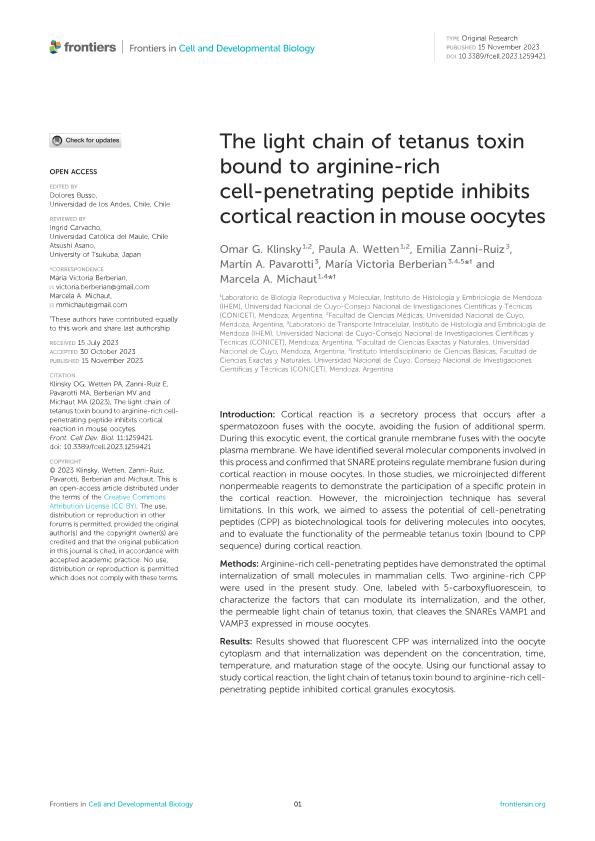Artículo
The light chain of tetanus toxin bound to arginine-rich cell-penetrating peptide inhibits cortical reaction in mouse oocytes
Klinsky Lahoz, Omar Guillermo ; Wetten, Paula
; Wetten, Paula ; Zanni Ruiz, Emilia; Pavarotti, Martin Alejandro
; Zanni Ruiz, Emilia; Pavarotti, Martin Alejandro ; Berberian, Victoria
; Berberian, Victoria ; Michaut, Marcela Alejandra
; Michaut, Marcela Alejandra
 ; Wetten, Paula
; Wetten, Paula ; Zanni Ruiz, Emilia; Pavarotti, Martin Alejandro
; Zanni Ruiz, Emilia; Pavarotti, Martin Alejandro ; Berberian, Victoria
; Berberian, Victoria ; Michaut, Marcela Alejandra
; Michaut, Marcela Alejandra
Fecha de publicación:
10/2023
Editorial:
Frontiers Media
Revista:
Frontiers in Cell and Developmental Biology
ISSN:
2296-634X
Idioma:
Inglés
Tipo de recurso:
Artículo publicado
Clasificación temática:
Resumen
Introduction: Cortical reaction is a secretory process that occurs after a spermatozoon fuses with the oocyte, avoiding the fusion of additional sperm. During this exocytic event, the cortical granule membrane fuses with the oocyte plasma membrane. We have identified several molecular components involved in this process and confirmed that SNARE proteins regulate membrane fusion during cortical reaction in mouse oocytes. In those studies, we microinjected different nonpermeable reagents to demonstrate the participation of a specific protein in the cortical reaction. However, the microinjection technique has several limitations. In this work, we aimed to assess the potential of cell-penetrating peptides (CPP) as biotechnological tools for delivering molecules into oocytes, and to evaluate the functionality of the permeable tetanus toxin (bound to CPP sequence) during cortical reaction. Methods: Arginine-rich cell-penetrating peptides have demonstrated the optimal internalization of small molecules in mammalian cells. Two arginine-rich CPP were used in the present study. One, labeled with 5-carboxyfluorescein, to characterize the factors that can modulate its internalization, and the other, the permeable light chain of tetanus toxin, that cleaves the SNAREs VAMP1 and VAMP3 expressed in mouse oocytes. Results: Results showed that fluorescent CPP was internalized into the oocyte cytoplasm and that internalization was dependent on the concentration, time, temperature, and maturation stage of the oocyte. Using our functional assay to study cortical reaction, the light chain of tetanus toxin bound to arginine-rich cell-penetrating peptide inhibited cortical granules exocytosis. Discussion: Results obtained from the use of permeable peptides demonstrate that this CPP is a promising biotechnological tool to study functional macromolecules in mouse oocytes.
Archivos asociados
Licencia
Identificadores
Colecciones
Articulos(ICB)
Articulos de INSTITUTO INTERDISCIPLINARIO DE CIENCIAS BASICAS
Articulos de INSTITUTO INTERDISCIPLINARIO DE CIENCIAS BASICAS
Articulos(IHEM)
Articulos de INST. HISTOLOGIA Y EMBRIOLOGIA DE MEND DR.M.BURGOS
Articulos de INST. HISTOLOGIA Y EMBRIOLOGIA DE MEND DR.M.BURGOS
Citación
Klinsky Lahoz, Omar Guillermo; Wetten, Paula; Zanni Ruiz, Emilia ; Pavarotti, Martin Alejandro; Berberian, Victoria; et al.; The light chain of tetanus toxin bound to arginine-rich cell-penetrating peptide inhibits cortical reaction in mouse oocytes; Frontiers Media; Frontiers in Cell and Developmental Biology; 11; 10-2023; 1-18
Compartir
Altmétricas



